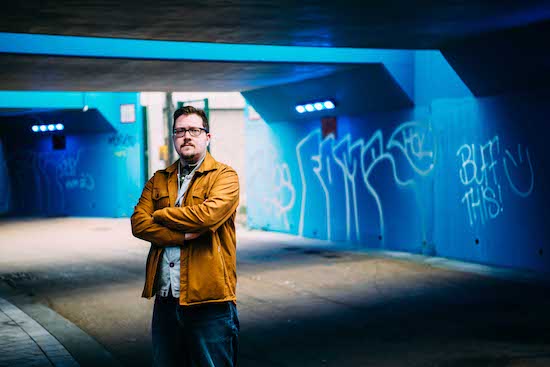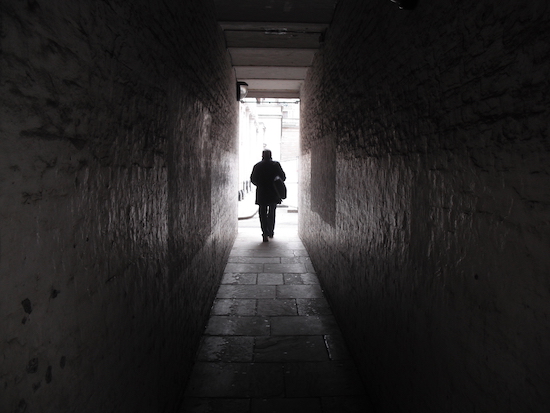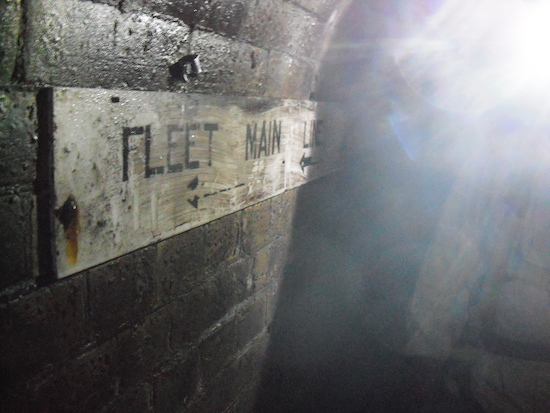Sewer Signage. Photo courtesy Tom Chivers
Born and raised south of the Thames, London’s rivers and lost waterways have remained embedded in Tom Chivers’ memories since his childhood. Describing London as a “liquid city”, Chivers’ book jumps from sinkholes and ancient Roman ruins in Aldgate to forgotten graves which have been eroded by the many forgotten waterways brooding underneath the streets.
Rather than a monograph covering the history of London’s lost rivers, be it the Effra or the Fleet, Chivers weaves a deeply personal narrative, which is not afraid to surprise the reader. Often lyrical, Chivers meanders through the city on a “pilgrimage” of sorts, stumbling upon traces of a rich history and reminders of days gone by.
While there have been previous titles uncovering forgotten stories literally stuck in the Thames’ mud as well as whole Youtube channels, it is Chivers’ lyrical narrative which makes London Clay so engaging.
How did you first think of the book?
I was doing a project called Adrift with a climate change arts charity [Cape Farewell]. And they allowed me to go and explore London’s lost landscape and lost rivers. I realised quite early on that I didn’t have the mental capacity to write about climate change in a meaningful way. What I did instead was look at London’s natural history. And I made this series of audio pieces people would follow as they walked down two of London’s lost rivers, the Walbrook and the Neckinger. From there sprung the idea of doing a book, which would follow not only the lost rivers of London, but also other hidden landscape features.
How has your background as a poet played into the book?
I don’t write poetry anymore. I started in my teens, and I see that as training. Training in language and training in sound. There are leaps of imagination I’m asking the reader to follow me on in the book, which probably come from that training as a poet. I think the surprise of that I would see as a poetic technique that I’ve taken into long form.

Author portrait by Akiko DuPont
How have you done the research for the book?
I’m not an academic. I’m not trained in any sort of research. But I did a certain amount of desk research. Reading and looking at maps – that was always important. And I would look very closely and work out any interesting stories that might emerge from that geological map. And then I would get out and walk the landscape again and again.
In the third chapter of the book, you mention the idea of liquidity and what you call a liquid city. Could you maybe tell us a bit more about that concept and what it tells us about London?
In that chapter, liquidity is used as a pun on financial liquidity. Following that particular river [the Walbrook] was exciting, because you were following this submerged stream. This hidden history for an area, which is generating huge amounts of capital now. So, there’s this strange dissonance created by that particular experience.
I think we tend to forget that London really is a water city. You think about places like the Shell Centre, which is literally built on a concrete raft floating in the clay… Or Waterloo station built on stilts. I suppose if I’m doing anything with the book, it’s trying to return us to this idea that water is fundamental not only for life, but also in this city.
In recent months, we’ve seen huge flooding. In a way, that is a warning that we need to be more mindful of how we treat water. Not just the water that comes out of our tap, but also how we build on places where water is indigenous to that landscape.
You often mention banks and the influence of finance in London. Would you say that the book is partly a commentary on the role of money in London’s history?
There’s always a temptation to have a strong opinion about the dealings of the City of London. I do have a strong opinion, because I used to live in Aldgate and it’s right on the edge of the city. I see the behaviour and the work ethics of the city and I’ve been quite critical of them. But when you take a much deeper look at the history of London, it is a city of making fortunes and always has been. Having said that, a lot of people are being priced out of the city.
Gentrification is such a loaded word. When I went to Elephant and Castle, which is an area that’s special to me, having grown up not too far away – it always had this magnetic quality – to see that amazing shopping centre being demolished for this new development… However, the developers might promise they will do this and the other, but we all know that luxury flats are always at the core of these new developments.
You frequently describe your time spent tracing lost rivers around London as a pilgrimage of sorts. What could this pilgrimage tell people who weren’t previously interested in the lost rivers of London?
Pilgrimage has clear and clearly religious implications across multiple faiths. But I think there is a more general impulse that binds it together. And that is to be walking with purpose. There’s an interplay between the idea of pilgrimage and the practice of psychogeography, which I’ve always seen, rightly or wrongly, as a slightly more aimless walking. There’s that wonderful sense that if you’re going on a pilgrimage, you’re walking in the footsteps of so many generations of people. If anyone was to pick this book up and be inspired to make a walk down one of London’s lost rivers, I would hope that they would bear both of those principles in mind.

Tokenhouse Yard. Photo courtesy Tom Chivers
Bearing in mind the latest floods in London, what does the book and its lost rivers tell us about London’s future under climate change?
I’m not a utopian. I certainly don’t believe that we can return to a prelapsarian paradise, It’s a city. It is a place where we’ve killed whole ecosystems. But I do think by being mindful of what is underneath our feet, I think it can teach us all to respect the geography and work with it rather than working against it. A good example of this is the Pudding Mill River. During the floods, there was that CCTV shot of a flooded tube station. That’s the Pudding Mill Lane DLR station.
Pudding Mill was a mill on the Pudding Mill River, which was a creek – one of the Bow Back creeks, connected to the River Lea. It was infilled in advance of the Olympics in 2012. No surprise that the Pudding Mill Lane DLR station floods, if you’re basically getting rid of a natural ditch that would hold floodwater. I’m not anti-development, but we need to develop with the geology and not against it.
How do these rivers influence our lives?
So many of us are unconsciously connected to the lost rivers. They determined the lie of the land. You can walk down Marylebone Lane: the exact bend of the Lane is the bend of the River Fleet. The curve of the architecture around St Pancras station follows the Fleet. There are lots of examples where we are unconsciously following these lost rivers. It’s a kind of startling revelation when you find out about London’s lost rivers.
Seeing how popular liminal spaces have become online, was the idea of liminality somehow important to the book?
It’s an interesting idea. But like all great ideas, it is quite hard to articulate precisely what it is. But I suppose it is an idea of a threshold. Some place that is transformative – either the place transforms or the place transforms you. In the book, I start off chapter two by going back to Herne Hill where I grew up. And Herne Hill is literally a liminal space between boroughs. Not quite Dulwich, not quite Brixton, not quite Camberwell.
Given how personal your book sometimes is, what can London’s lost rivers and the book itself tell its readers? Perhaps even about themselves?
I can only speak of how I think the landscape and my wandering around has affected me. It’s given me a real sense of identity. And in a way, it’s allowed me to overcome loss. There’s something obsessive about the way that I’ve walked around London. If you’ve read the book, the second chapter, which looks at my mum’s death, I suppose it felt transformative. It felt in some way bettering and relieving to be going back to those landscapes that are for me associated with loss.
There are a lot of ghosts in the book. And I’m always hoping that the ghosts that I missed will come back and haunt me. That’s the connection. It’s about things that are visible and things that are invisible. And our desire to use the technical term for recovering lost rivers, daylight those invisible things that we desire to see again.
On a lighter note, knowing that you’ve just covered this in your book to a great extent, is there some kind of fundamental difference between London north of the Thames and south of it?
We’re friendlier here [laughs].
London Clay: Journeys in the Deep City by Tom Chivers is published by Doubleday, an imprint of Penguin Random House


